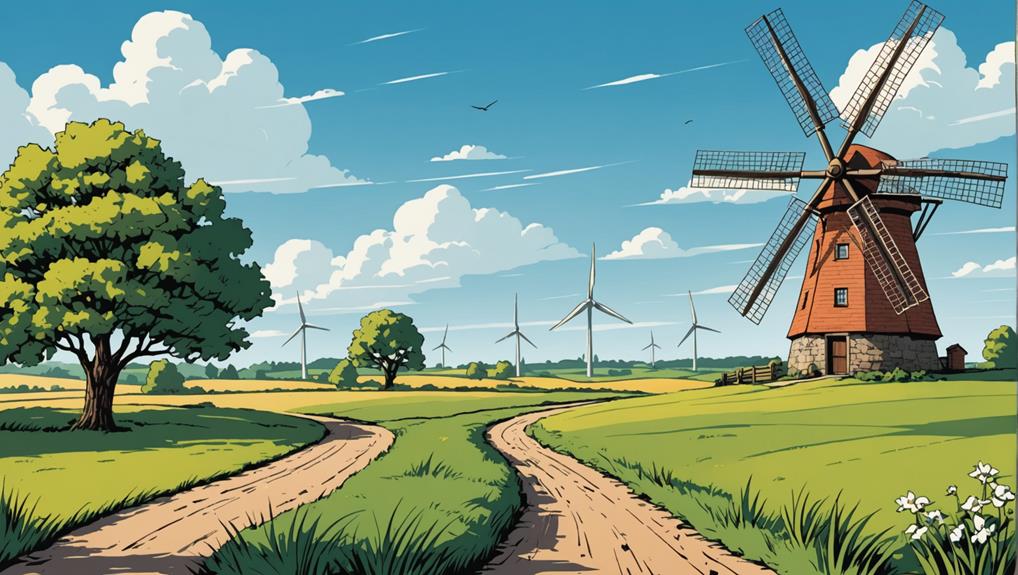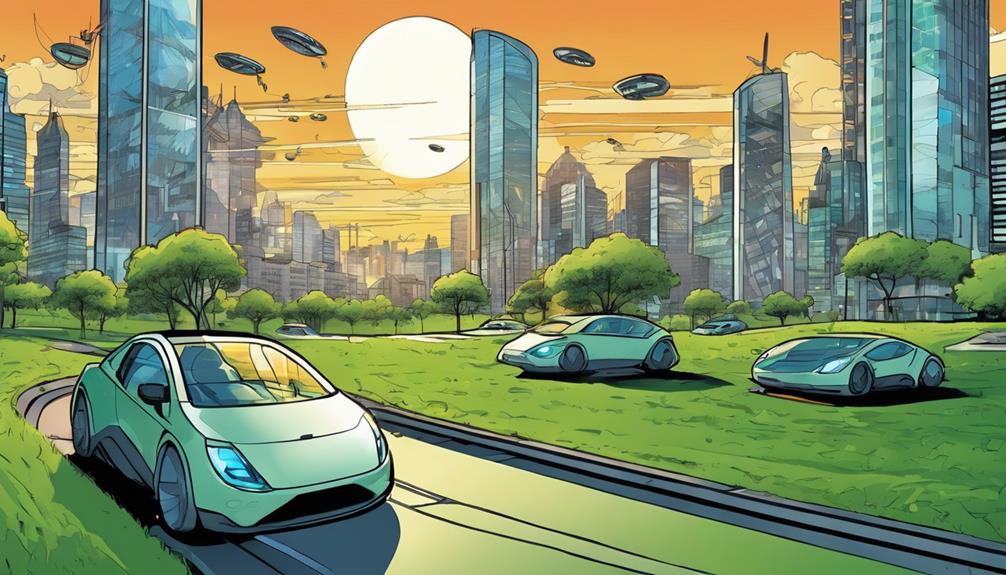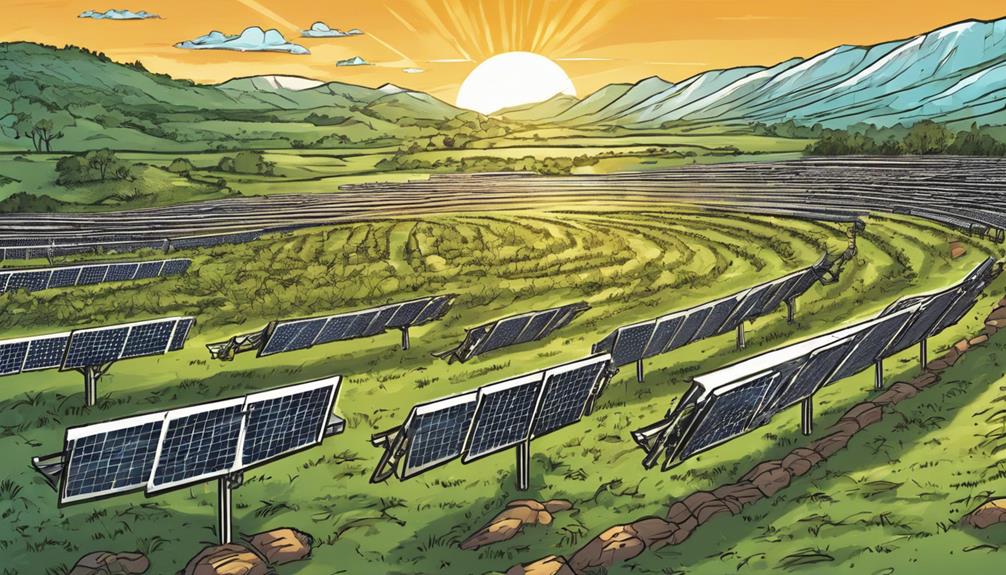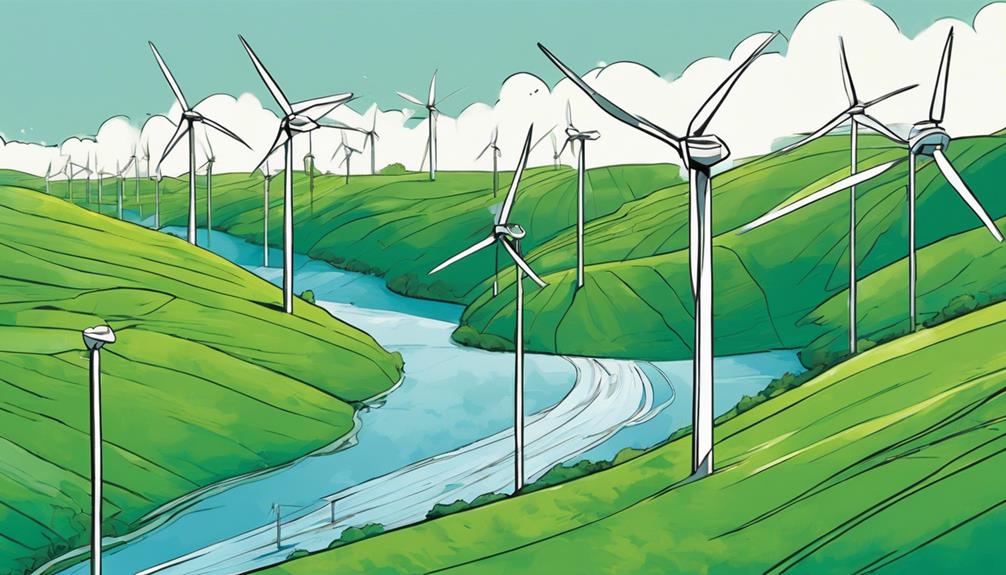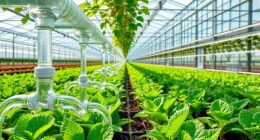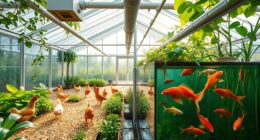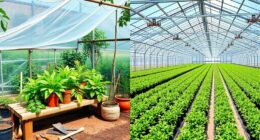When comparing wind turbines and windmills, it's important to highlight the main difference in how they operate. Windmills convert wind energy into mechanical power for tasks like grinding grain and pumping water. In contrast, wind turbines harness wind energy to produce electricity, using fewer blades than windmills. Wind turbines generate power through the rotation of blades interacting with magnetic fields in the generators. Understanding their unique mechanisms helps grasp their distinct roles in harnessing wind power effectively.
Key Takeaways
- Windmills convert wind energy into mechanical power for tasks like grinding grain and pumping water.
- Wind turbines harness wind energy to generate electricity for residential and industrial use.
- Windmills have been in existence for centuries, while wind turbines are a modern technology.
- Windmills typically have more blades and are used for mechanical tasks, while wind turbines have fewer blades and generate electricity.
- Wind turbines play a significant role in renewable energy production and reducing greenhouse gas emissions.
Wind Energy Technology
Wind energy technology has evolved significantly over the years, harnessing the power of wind to generate electricity efficiently. Wind turbines play a vital role in this advancement, with their innovative design maximizing energy production. These turbines consist of blades that rotate when the wind blows, turning a camshaft and interacting with magnetic fields to produce electricity. Typically, wind turbines are equipped with three blades to ensure optimal balance and efficiency in converting wind energy into electrical power. This design allows for a smoother rotation, enhancing the overall performance of the turbine.
The evolution of wind energy technology has led to significant improvements in the efficiency of wind turbines. Innovations in blade design, materials, and aerodynamics have all contributed to enhancing the capabilities of these turbines. As a result, modern wind turbines are capable of generating substantial amounts of electricity from the wind, making them a key player in the renewable energy sector.
Historical Development

Dating back to the 9th century, the historical development of wind technology showcases the early origins and evolution of windmills and wind turbines. Windmills, initially originating in Persia, became prevalent in Europe by the 17th century, primarily used for tasks like grinding grain and pumping water.
In contrast, wind turbines, designed to generate electricity, emerged later. The first wind turbine for electricity generation was constructed in 1887 in Ohio, marking a significant leap in wind technology.
Denmark's adoption of wind power was evident with 2,500 wind turbines by 1900, highlighting an early embrace of wind energy for electricity production.
Wind Energy Applications

The utilization of wind energy extends beyond historical agricultural purposes, encompassing diverse applications in modern society. Wind turbines play an essential role in generating clean electricity for offsite use, particularly in remote areas where grid access is limited.
Distributed wind resources, such as small-scale turbines, cater to individual customers seeking sustainable energy solutions. In addition to powering homes and businesses, wind energy is harnessed by dairy farms and net-zero homeowners to reduce environmental impact.
Windmills, on the other hand, continue to serve vital functions in rural areas. They're employed for pumping water and providing power to communities where modern infrastructure may be lacking.
The Africa Windmill Project stands out as a notable example, utilizing windmills to irrigate farmlands and enhance agricultural productivity in rural Africa. By blending traditional practices with innovative technology, wind energy applications contribute to sustainable development and resource conservation on a global scale.
Environmental Impact and Wildlife Concerns

You need to take into account wildlife protection strategies when discussing wind turbines, especially regarding the impacts of blade length on birds and bats.
Solutions like recyclable blade options are being developed to address the environmental concerns associated with decommissioned turbines.
It's essential to balance renewable energy goals with wildlife conservation efforts to combat the threats posed by climate change.
Wildlife Protection Strategies
Implementing effective wildlife protection strategies in wind energy projects is crucial for minimizing environmental impact and addressing wildlife concerns. When it comes to protecting wildlife in wind energy projects, consider the following key strategies:
- Proper Siting: Ensure wind farms are located in areas that minimize risks to migrating birds and bats, reducing the potential for bird collisions.
- Recyclable Blades: Utilize recyclable wind turbine blades to decrease the environmental impact of wind energy projects and promote sustainability.
- Research and Monitoring: Engage in ongoing research and monitoring efforts to understand and mitigate the impact of climate change on bird populations, thereby enhancing wildlife protection in wind energy projects.
Blade Length Impacts
Considering the environmental impact and wildlife concerns, longer turbine blades on wind turbines can pose an increased risk of bird and bat collisions. The extended blade length can alter bird and bat behavior and migration patterns, leading to a higher chance of collisions with the rotating blades.
Proper siting of wind farms is vital to mitigate these wildlife impacts, as locating turbines away from known migration routes or important habitats can help reduce the risk to birds and bats.
To address the environmental impact of turbine blades, researchers are developing recyclable blades that aim to minimize waste and decrease the ecological footprint of wind energy production.
As climate change poses a significant threat to bird populations, the development of wildlife-friendly wind turbine designs becomes even more important to ensure the sustainability of renewable energy sources while safeguarding avian species.
Recyclable Blade Solutions
Innovations in recyclable blade solutions are essential for reducing the environmental impact and addressing wildlife concerns associated with wind turbine technology. When contemplating sustainable practices in wind energy, focusing on recyclable blade solutions is vital.
To tackle the challenges related to blade waste, proper disposal methods are being developed, emphasizing the need for environmentally friendly practices.
Here are key points to keep in mind:
- Recyclable blade solutions: Exploring materials like thermoplastic composites can enhance recyclability and reduce the environmental footprint of wind turbine decommissioning.
- Sustainable practices: Implementing sustainable practices in the disposal of wind turbine blades is important for minimizing environmental impact and promoting eco-friendly solutions.
- Proper disposal methods: Developing effective methods for disposing of wind turbine blades is essential to address the growing concerns regarding blade waste and its impact on the environment.
Wind Turbine Design and Efficiency

Wind turbine design significantly influences the efficiency and energy production of wind turbines. Typically, wind turbines are equipped with three blades, which offer excellent stability and efficiency in converting wind energy into electricity. This design choice maximizes the amount of energy produced while ensuring safe and reliable operation.
Unlike one- or two-blade turbines, which are less common due to reduced stability and durability, three-blade configurations are the preferred choice for maximizing electricity generation efficiency. It's essential to mention that adding more than three blades to a turbine can increase wind resistance, ultimately leading to lower efficiency in producing electricity.
Additionally, updating wind facilities with modern technology, known as repowering, can have a significant impact on both wildlife mortality rates and overall operational efficiency. By recognizing the crucial role of wind turbine design in maximizing efficiency and energy production, the renewable energy sector can continue to advance towards a more sustainable future.
Historical and Modern Applications

Windmills, with their rich history and diverse applications, have evolved from necessary mechanical power sources to iconic symbols of traditional energy methods.
When comparing windmills to wind turbines, it's important to understand their historical and modern applications:
Historical Importance: Windmills historically served pivotal roles in agriculture and water management, and today, they stand as tourist attractions and reminders of traditional energy sources. They were fundamental in powering pumps and factories as mechanical energy generators.
Modern Functions: Wind turbines, on the other hand, generate clean electricity, contribute to grids, combat climate change, and play a significant role in sustainable energy strategies. They focus on converting wind energy into electrical energy efficiently, starting to produce energy at wind speeds as low as 5-10 mph.
Evolution and Innovation: While windmills have been in existence for over a millennium, primarily used for milling grain and pumping water, wind turbines represent newer technology. They reach greater heights, harnessing wind power to generate electricity, contributing notably to renewable energy sources.
Environmental and Economic Benefits

By harnessing wind energy, both environmentally and economically beneficial outcomes are realized. Wind power plays a significant role in reducing greenhouse gas emissions, aligning with renewable energy goals and combating climate change. Additionally, the implementation of wind technology not only promotes cleaner environments by lowering air pollution levels but also aids in conserving natural resources and supporting biodiversity conservation efforts.
From an economic standpoint, wind turbines create employment opportunities in manufacturing and maintenance sectors, stimulating local economies. Furthermore, these structures contribute to lowering long-term energy costs, attracting investments in renewable energy and promoting sustainable development practices.
The financial advantages of utilizing wind power extend beyond immediate savings, providing a pathway towards a more sustainable and economically viable future. Embracing wind energy not only offers environmental benefits but also fosters economic growth, making it a compelling choice in the shift towards a more sustainable energy landscape.
Windmill Vs. Wind Turbine Mechanisms

Let's start by comparing the mechanisms and functions of windmills and wind turbines. Windmills operate by converting wind energy into mechanical power, used for tasks like grinding grain and pumping water.
In contrast, wind turbines harness wind energy to generate electricity through a different operational process.
Mechanisms and Functions
Understand how windmills and wind turbines differ in their mechanisms and functions for energy conversion.
When it comes to converting wind energy, windmills and wind turbines operate differently. Windmills utilize their large circular blades to capture wind energy and convert it into mechanical power, suitable for tasks like grinding grain and pumping water.
On the other hand, wind turbines are designed to convert wind energy into electrical power through the rotation of their blades and generators.
Here are three key differences in the mechanisms and functions of windmills and wind turbines:
- Windmills use their blades to convert wind energy into mechanical power for specific tasks.
- Wind turbines have fewer blades compared to windmills to optimize the generation of electricity.
- Windmills operate based on pressure differences, while wind turbines rely on lift and drag forces for the conversion of wind energy into electrical power.
Operational Contrasts
The operational contrasts between windmills and wind turbines lie in how they convert wind energy into different forms of energy. Windmills utilize wind to turn large circular blades, converting wind into rotational energy for mechanical tasks like grinding grain and pumping water. On the other hand, wind turbines employ fewer, more aerodynamic blades that spin to drive a generator, transforming wind energy into electrical energy for electricity production.
To better understand the operational disparities between windmills and wind turbines, let's compare them side by side:
| Aspect | Windmill | Wind Turbine |
|---|---|---|
| Energy Conversion | Wind into rotational energy | Wind into electrical energy |
| Energy Usage | Mechanical tasks | Generating electricity |
| Blade Design | Larger blades | Fewer, aerodynamic blades |
| Dependence on Wind Speed | Relatively less dependent | More sensitive to wind speed |
Global Impact of Wind Energy
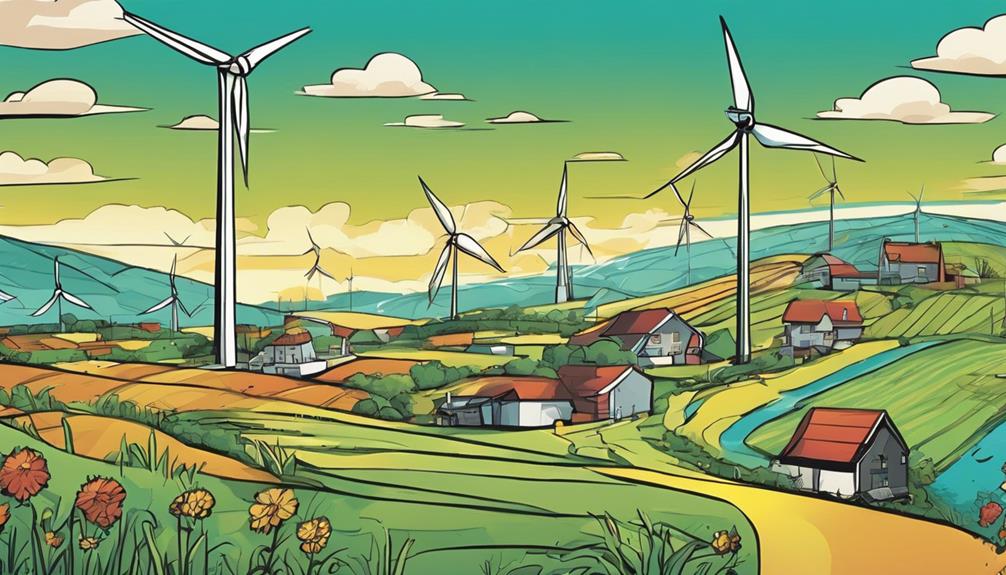
With wind turbines producing 5% of global electricity in 2018, their significant contribution to renewable energy is undeniable. Wind energy plays a pivotal role in combating climate change and promoting sustainable energy practices globally. Here's how wind power is making a difference:
- Environmental Benefits: Wind projects repay their carbon footprint within six months, showcasing the environmental advantages of wind energy. By reducing carbon fuel dependency, wind power helps combat climate change on a large scale.
- Lowered Air Pollution: Wind technology aids in lowering air pollution levels and conserving natural resources worldwide. This reduction in pollution not only benefits the environment but also improves the overall health and well-being of communities.
- Biodiversity Conservation: Wind turbines support biodiversity conservation efforts by reducing greenhouse gas emissions and promoting sustainable energy practices. By choosing wind energy, we contribute to a greener planet and a more sustainable future for all living beings.
Frequently Asked Questions
What Is the Difference Between Windmills and Wind Turbines?
When comparing windmills and wind turbines, note that windmills convert wind energy to mechanical energy, while wind turbines transform wind energy into electrical power. The distinction lies in their functionality: one performs mechanical tasks, the other produces electricity.
What Is the Difference Between a Windmill and a Wind Turbine for Kids?
For kids, a windmill grinds grains and pumps water, while a wind turbine makes electricity. Windmills have big blades for chores, and turbines have fewer blades for power. Windmills are ancient, turbines are modern.
Why Are Wind Turbines Called Windmills?
When you think about it, wind turbines are called windmills because they both work with the wind to produce energy. It's like saying two peas in a pod – different names, same green goodness!
How Do You Understand a Windmill?
To understand a windmill, you observe its large blades harnessing wind energy for mechanical tasks like grinding grain. Windmills, with their historical significance in various industries, showcase the efficient conversion of wind power into mechanical energy for practical applications.
How Do Wind Turbines and Windmills Contribute to Wind Energy in the Power Grid?
Wind turbines and windmills play a crucial role in harnessing the power of wind energy for the power grid. By converting the kinetic energy of the wind into electricity, they contribute to the overall generation of sustainable and clean energy. The role of wind energy in our power grid continues to grow as we strive towards a more environmentally friendly future.
How Does the Energy Source Differ Between a Wind Turbine and a Windmill?
A wind turbine uses a generator energy source to convert wind energy into electricity, while a windmill uses the same generator energy source to grind grain or pump water. The main difference lies in how the generated energy is utilized, with turbines producing electrical energy and windmills performing mechanical tasks.
How Do Wind Turbines and Windmills Play a Role in Wind Farms?
Wind turbines and windmills are essential components of wind farms. They harness the power of the wind to generate electricity, providing significant wind farm benefits and challenges. While they offer renewable energy and contribute to reducing greenhouse gas emissions, they also face obstacles such as noise pollution and potential harm to wildlife.
Conclusion
To sum up, understanding the differences between wind turbines and windmills is key to appreciating the impact of wind energy technology.
Did you ever stop to think about how these towering structures harness the power of the wind to generate clean, renewable electricity?
From ancient windmills to modern wind turbines, the evolution of this technology has reshaped the way we think about sustainable energy sources.
So next time you see a wind turbine spinning gracefully in the breeze, remember the incredible potential of wind power.

